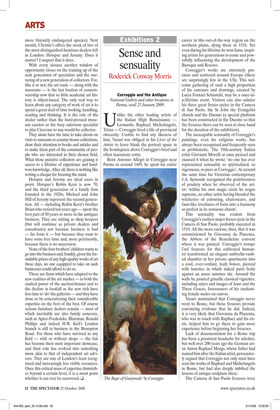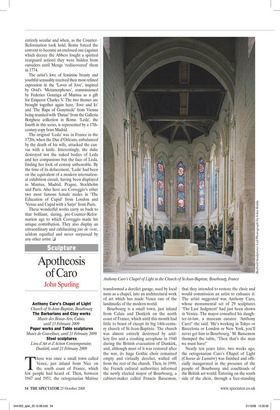Sense and sensuality
Roderick Conway Morris
Correggio and the Antique National Gallery and other locations in
Parma, until 25 January 2009 Unlike the other leading artists of the Italian High Renaissance — Leonardo, Raphael, Michelangelo, Titian — Correggio lived a life of provincial obscurity. Unable to find any likeness of him, Vasari was obliged in his Lives of the Artists to leave blank the portrait space in the frontispiece above Correggio’s brief and often inaccurate entry.
Born Antonio Allegri in Correggio near Parma in around 1489, he spent his entire career in this out-of-the-way region on the northern plains, dying there in 1534. Yet even during his lifetime he won fame, inspiring artists for generations to come and powerfully influencing the development of the Baroque and Rococo.
Correggio’s works are extremely precious and scattered around Europe (there are surprisingly few in the US). This welcome gathering of such a high proportion of his canvases and drawings, curated by Lucia Fornari Schianchi, may be a once-ina-lifetime event. Visitors can also admire his three great fresco cycles in the Camera di San Paolo, the St John the Evangelist church and the Duomo (a special platform has been constructed in the Duomo so that the frescoes there can be seen at close hand for the duration of the exhibition).
The inescapable sensuality of Correggio’s paintings, even his religious works, has always been recognised and frequently seen as problematic. The 19th-century Italian critic Giovanni Morelli at once praised and excused it when he wrote: ‘no one has ever represented sensuality so spiritualised, so ingenuous, so pure as Correggio’. At around the same time his Victorian contemporary J.A. Symonds recognised the pointlessness of prudery when he observed of the artist: ‘within his own magic circle he reigns supreme, no other artist having blended the witcheries of colouring, chairoscuro, and faun-like loveliness of form into a harmony so perfect in its sensuous charm’.
This sensuality was evident from Correggio’s earliest major fresco cycle in the Camera di San Paolo, probably executed in 1519. All the more curious, then, that it was commissioned by Giovanna da Piacenza, the Abbess of the Benedictine convent where it was painted. Correggio’s trompe l’oeil frescoes for this cultivated humanist transformed an elegant umbrella-vaulted chamber in her private apartments into a cool, ever-verdant, leafy bower, pierced with lunettes in which naked putti frolic against an azure summer sky. Around the walls he painted grisaille classical vignettes, including satyrs and images of Juno and the Three Graces, forerunners of his enchanting female nudes on canvas.
Vasari maintained that Correggio never went to Rome, but these frescoes provide convincing evidence that he did. Indeed, it is very likely that Giovanna da Piacenza, who was in touch with Raphael and his circle, helped him to go there to gain more experience before beginning her frescoes.
Lack of documentation for a Rome trip has been a persistent headache for scholars, but well over 200 years ago the German artist Anton Raphael Mengs, whose father had named him after the Italian artist, persuasively argued that Correggio not only must have seen the works of Raphael and Michelangelo in Rome, but had also deeply imbibed the lessons of antique sculpture there.
The Camera di San Paolo frescoes were entirely secular and when, as the CounterReformation took hold, Rome forced the convent to become an enclosed one (against which decree the Abbess fought a spirited rearguard action) they were hidden from outsiders until Mengs ‘rediscovered’ them in 1774.
The artist’s love of feminine beauty and youthful sensuality received their most refined expression in the ‘Loves of Jove’, inspired by Ovid’s ‘Metamorphoses’, commissioned by Federico Gonzaga of Mantua as a gift for Emperor Charles V. The two themes are brought together again here, ‘Jove and Io’ and ‘The Rape of Ganymede’ from Vienna being reunited with ‘Danae’ from the Galleria Borghese collection in Rome. ‘Leda’, the fourth in this series, is represented by a 17thcentury copy from Madrid.
The original ‘Leda’ was in France in the 1720s, when the Duc d’Orleans, unbalanced by the death of his wife, attacked the canvas with a knife. Interestingly, the duke destroyed not the naked bodies of Leda and her companions but the face of Leda, finding her look of ecstasy unbearable. By the time of its defacement, ‘Leda’ had been on the equivalent of a modern international exhibition circuit, having been displayed in Mantua, Madrid, Prague, Stockholm and Paris. Also here are Correggio’s other two most famous female nudes in ‘The Education of Cupid’ from London and ‘Venus and Cupid with a Satyr’ from Paris.
These wonderful works carry us back to that brilliant, daring, pre-Counter-Reformation age to which Correggio made his unique contribution. They also display an extraordinary and exhilarating joie de vivre, seldom equalled and never surpassed by any other artist. ❑



















































































 Previous page
Previous page